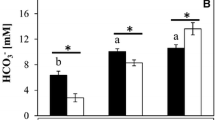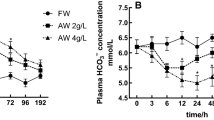Summary
Carbonic anhydrase (CA) activities in gills and venous blood, acid-base balance, and haematological variables were studied during environmental hypercapnia in rainbow trout (Salmo gairdneri). Batches of 8–10 fish were exposed to about 3 or 13 mmHg\(P_{{\text{CO}}_{\text{2}} } \) in flow-through tests of various duration from 4 h to 80 days.
After initial acidosis, blood pH rose above pre-experimental values. At 3 mmHg it became normal again within 21 days, while at 13 mmHg the overshoot lasted for 80 days. In fish acclimated for 3 weeks or more to 13 mmHg\(P_{{\text{CO}}_{\text{2}} } \), blood HCO −3 increased four to five times while plasma Cl− levels were lower and K+ higher. Na+ levels did not show any consistent trend associated with exposure to hypercapnia. After an initial acidaemia, Hct, Hb, and RBC remained relatively constant.
Patterns of change in CA activity differed between gills and erythrocytes. Initially, blood CA decreased at both\(P_{{\text{CO}}_{\text{2}} } \) levels. It then began rising after about 3 weeks and tended to reach pre-experimental values by 80 day's hypercapnia. At 13 mmHg\(P_{{\text{CO}}_{\text{2}} } \), gill CA increased to twice the pre-experimental level. Compared with blood CA, gill CA appeared to be more specifically involved in fish acclimation to hypercapnia, which demands an increase in blood bicarbonate to provide a sufficient buffering capacity. Increased CA indicates that the gill enzyme may play a more important role than blood CA in acid-base regulation in fish during hypercapnia.
Similar content being viewed by others
Abbreviations
- CA :
-
carbonic anhydrase
- Hb :
-
haemoglobin
- Hct :
-
haematocrit value
- RBC :
-
red blood cells
References
Ahlgren I, Ahlgren G (1976) Water chemical analysis. Mimeographed in Swedish. Department of Limnology, Uppsala University, Sweden
Astrup P (1956) A simple electrometric technique for the determination of carbon dioxide tension in blood and plasma, total content of carbon dioxide in plasma, and bicarbonate content in ‘separated’ plasma at a fixed carbon dioxide tension (40 mmHg). Scand J Clin Lab Invest 8:33–43
Börjeson H (1977) Effects of hypercapnia on the buffer capacity and haematological values inSalmo salar (L.). J Fish Biol 11:133–142
Börjeson H, Höglund LB (1976) Swimbladder gas and Root effect in young salmon during hypercapnia. Comp Biochem Physiol 54A:335–339
Boutilier RG, Heming TA, Iwana GK (1984) Physicochemical parameters for use in fish respiratory physiology In: Hoar WS, Randall DJ (eds) Fish Physiology, vol XA. Academic Press, New York, London, pp 403–430
Cameron JN (1976) Branchial ion uptake in Arctic grayling: resting values and effects of acid-base disturbance. J Exp Biol 64:711–725
Christensen GM, Tucker JH (1976) Effects of selected water toxicants on the in vitro activity of fish carbonic anhydrase. Chem Biol Interactions 13:181–192
De Renzis G (1975) The branchial chloride pump in the goldfish (Carassius auratus): relationship between Cl−/HCO −3 and Cl−/Cl− exchanges and the effect of thiocyanate. J Exp Biol 63:587–602
Dimberg K, Höglund LB, Knutsson PG, Ridderstråle Y (1981) Histochemical localization of carbonic anhydrase in gill lamellae from young salmon (Salmo salar L.) adapted to fresh and salt water. Acta Physiol Scand 112:218–220
Eddy FB, Smart GR, Bath RN (1979) Ionic content of muscle and urine in rainbow trout (Salmo gairdneri Richardson) kept in water of high CO2 content. J Fish Diseases 2:105–110
Hansen P, Magid E (1966) Studies on a method of measuring carbonic anhydrase activity. Scand J Clin Lab Invest 18:21–32
Hansson HPJ (1968) Histochemical demonstration of carbonic anhydrase activity in some epithelia noted for active transport. Acta Physiol Scand 73:427–434
Haswell MS (1978) CO2 excretion and acid-base regulation in the rainbow trout,Salmo gairdneri (PhD thesis). University of British Columbia, Vancouver, Canada
Haswell MS, Randall DJ (1976) Carbonic anhydrase inhibitor in trout plasma. Respir Physiol 28:17–27
Heisler N (1984) Acid-base regulation in fishes. In: Hoar WS, Randall DJ (eds) Fish Physiology, vol XA. Academic Press, New York, London, pp 315–401
Heming TA, Watson TA (1986) Activity and inhibition of carbonic anhydrase inAmia calva, a bimodal-breathing holostean fish. J Fish Biol 28:385–392
Henry RP, Cameron JN (1982) The distribution and partial characterization of carbonic anhydrase in selected aquatic and terrestrial decapod crustaceans. J Exp Zool 221:309–321
Höglund LB, Börjeson H (1971) Acidity and lactate content in the blood of young Atlantic salmon (Salmo salar, L.) exposed to high pCO2. Rep Inst Freshwat Res Drottningholm 51:67–74
ICSH, International committee for standardization in haematology of the European Society of Haematology (1965) Recommendation and requirements for hemoglobinometry in human blood. Scand J Clin Lab Invest 17:617–620
Lloyd R, White WR (1967) Effect of high concentration of carbon dioxide on the ionic composition of rainbow trout blood. Nature (Lond) 216:1341–1342
Maetz J (1971) Fish gills: mechanisms of salt transfer in fresh-water and sea water. Phil Trans R Soc Lond 262B:209–249
McDonald DG, Wood CM (1981) Branchial and renal acid and ion fluxes in the rainbow trout (Salmo gairdneri) at low environmental pH. J Exp Biol 93:101–118
Perry SF (1982) The regulation of hypercapnic acidosis in two salmonids, the freshwater trout (Salmo gairdneri) and the seawater salmon (Oncorhynchus kisutch). Mar Behav Physiol 9:73–79
Perry SF (1986) Carbon dioxide excretion in fishes. Can J Zool 64:565–572
Perry SF, Haswell MS, Randall DJ, Farrell AP (1981) Branchial ionic uptake and acid-base regulation in the rainbow trout (Salmo gairdneri). J Exp Biol 92:289–303
Railo E, Nikinmaa M, Soivio A (1985) Effects of sampling on blood parameters in the rainbow trout,Salmo gairdneri Richardson. J Fish Biol 26:725–732
Wilkes PRH, McMahon BR (1986) Responses of a stenohaline freshwater teleost (Catostomus commersoni) to hypersaline exposure. J Exp Biol 121:77–94
Wood CM, McDonald DG (1982) The influence of experimental anaemia on blood acid-base regulation in vivo and in vitro in the starry flounder (Platichtys stellatus) and the rainbow trout (Salmo gairdneri). J Exp Biol 96:221–237
Author information
Authors and Affiliations
Rights and permissions
About this article
Cite this article
Dimberg, K., Höglund, L.B. Carbonic anhydrase activity in the blood and the gills of rainbow trout during long-term hypercapnia in hard, bicarbonate-rich freshwater. J Comp Physiol B 157, 405–412 (1987). https://doi.org/10.1007/BF00691823
Accepted:
Issue Date:
DOI: https://doi.org/10.1007/BF00691823




